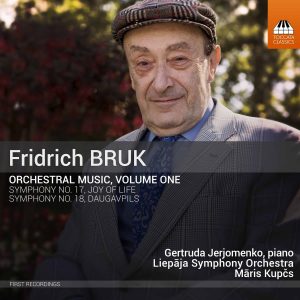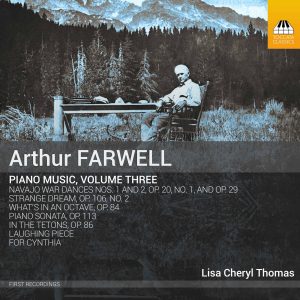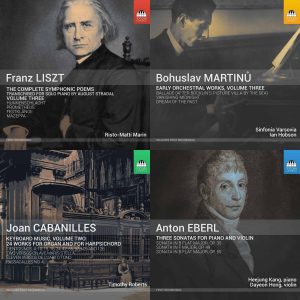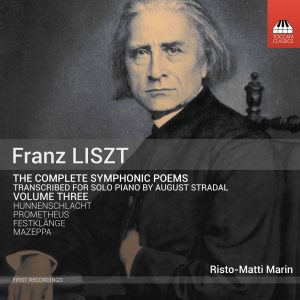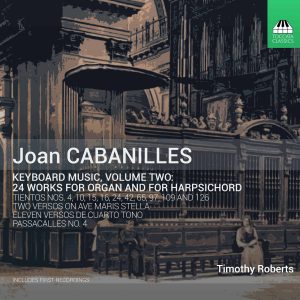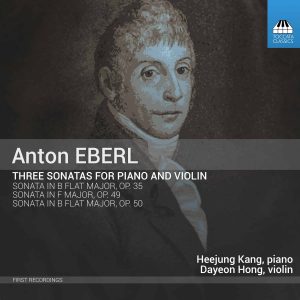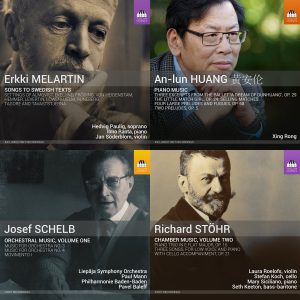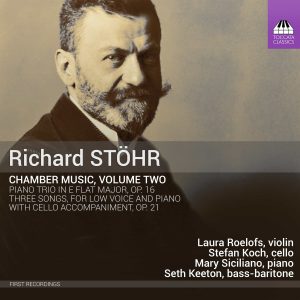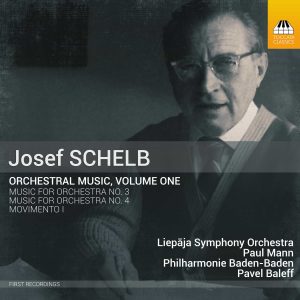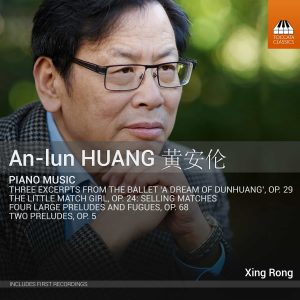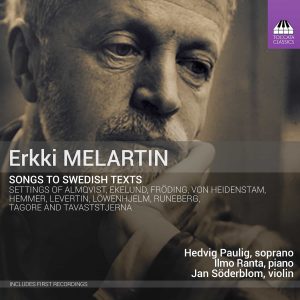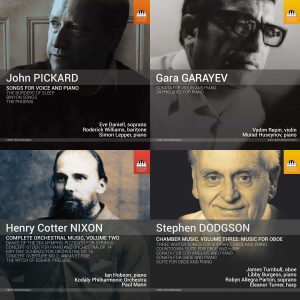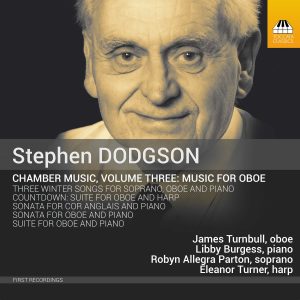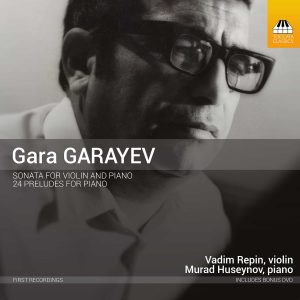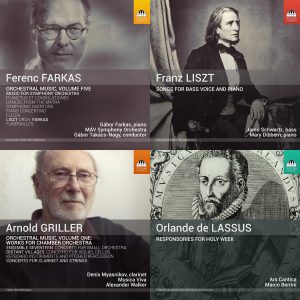Search Results for "Space Wolf: The First Omnibus mp3 torrent" – Page 59
Fridrich Bruk: Orchestral Music, Volume One
Fridrich Bruk – born in Kharkov in 1937 and a Finnish resident since 1974 – made his name as a composer of tangos. But the heart of his music lies in a series of eighteen symphonies, which have a strong narrative element, some reflecting Jewish themes, others inspired by Karelia and Finland. Symphony No. 17, Joy of Life (which Bruk also calls a ‘Concerto-Symphony for Orchestra and Piano’), has an autobiographical programme charting, in abstract terms, Bruk’s surmounting of the obstacles fate put in his path. Symphony No. 18 takes as its starting point a Latvian-Jewish folksong: it is premised on the deportation of his grandparents from their Latvian home, in an anti-Semitic campaign by Tsarist Russia that Bruk sees as a kind of prologue to the Holocaust.
Gertruda Jerjomenko, piano
Anda Eglīte, kokle (Tracks 4–11)
Liepāja Symphony Orchestra
Māris Kupčs, conductor
Arthur Farwell: Piano Music, Volume Three
The American composer Arthur Farwell (1872–1952) is remembered as the leading member of a group of ‘Indianists’ who used Native American tribal melodies in their own compositions. But Farwell’s stylistic range was much wider than is realised today. This third album of his piano music reveals the influence of both Debussy and Skryabin, perhaps even Busoni and, in the two ‘Navajo War Dances’ here, intriguing parallels with Bartók – all refracted through an imaginative mind with a sharp sense of keyboard drama, colour and atmosphere.
Lisa Cheryl Thomas, piano
Jared Schwartz Bundle
Included in this bundle:
January 2018 Bundle
Included in this bundle:
Liszt: Symphonic Poems, Volume Three
Although Liszt’s thirteen symphonic poems exist in two-piano transcriptions prepared by the composer himself, it was his Czech student August Stradal (1860–1930) who was to transcribe them for solo piano – versions which demand almost superhuman virtuosity. As the late Malcolm MacDonald writes in his booklet essay, Stradal’s versions ‘transform these revolutionary orchestral compositions into viable and effective piano works, faithfully preserving their masterly musical substance’. A Fanfare review of Volume One in this series had high praise for Risto-Matti Marin’s pianism: ‘One marvels at the stamina that can keep such a plethora of detail in place with such relentless élan; at his narrative shaping, which can turn up an already withering heat, so to speak, at climactic moments; at his overarching persuasiveness’.
Risto-Matti Marin, piano
Joan Cabanilles Keyboard Music: Volume Two
Much of the music of Joan (or Juan) Cabanilles (1644–1712) is as virtuosic and colourfully Baroque as that of his northern contemporary, Dietrich Buxtehude, though it is also touched with a distinctively Spanish intensity. He is claimed as the most prolific of all composers for the organ, and publication of his works, begun in 1927, is still under way. This is the second in an ongoing series of recordings designed to restore a great Valencian master to his unique glory.
Timothy Roberts
Organ of the Church of Sant Jaume, Vila-real, Valencia (Tracks 1–20)
Organ of the Church of San José, Navalcarnero, Madrid (Tracks 21–22)
Harpsichord (Tracks 23–24)
Anton Eberl: Three Sonatas for Piano and Violin
At the beginning of his career, the Viennese pianist-composer Anton Eberl (1765–1807) had to put up with the doubtful flattery of seeing some of his works published under the name of Mozart, who was a friend and supporter. But Eberl’s charming and elegant music deserves to be remembered in its own right: it engages in remarkably imaginative and experimental formal innovations, developing the Viennese Classical style beyond the point at which Mozart had left it, to a degree of refinement that led Eberl’s contemporaries to prefer his compositions to Beethoven’s.
Heejung Kang, piano
Dayeon Hong, violin
December 2017 Bundle
Included in this bundle:
Richard Stöhr: Chamber Music, Volume Two
Like Korngold, Toch, Schoenberg, Zeisl and Zemlinsky, Richard Stöhr (1874–1967) was another Austrian composer driven into American exile by the Nazis. His generous output of music – ripe for rediscovery – includes seven symphonies, fifteen violin sonatas among much other chamber music, songs, and choral and piano pieces. His expansive E flat Piano Trio of 1905 sits firmly in the Viennese Romantic tradition downstream from Schubert and Brahms, with one lovely tune following another, whereas the Three Songs, written only four years later, look forward to the lyrical intensity of Korngold.
Laura Roelofs, violin (Tracks 1-4)
Stefan Koch, cello
Mary Siciliano, piano
Seth Keeton, bass-baritone (Tracks 5-7)
Josef Schelb: Orchestral Music, Volume One
Josef Schelb (1894–1977) is one of the better-kept secrets of German music. His output was substantial: he lost most of his early music in a bombing raid in 1942 but, as if to make up for lost time, wrote some 150 more works after that, in the tonally liberated, quasi-Expressionist contrapuntal tradition of Hindemith and Hartmann; Bartók was an important influence, too. The three pieces recorded here show Schelb capable of astonishing vitality in his mid- to late seventies: they display lean muscularity, freewheeling energy and luminous and transparent orchestration, often informed by bucolic nostalgia and lyrical melancholy.
Liepāja Symphony Orchestra (Tracks 1 – 4)
Paul Mann, conductor (Tracks 1 – 4)
Philharmonie Baden-Baden (Tracks 5 – 7)
Pavel Baleff, conductor (Tracks 5 – 7)
An-Lun Huang 黄安伦: Piano Music
An-lun Huang, born in Guang Zhou, Guangdong, in 1949, and a resident of Toronto since 1986, survived the hardships of the Cultural Revolution to make his mark as pianist and composer both in China and in the west. In his piano music he is concerned to find a meeting ground between the piano as a western instrument and his own roots as a Chinese musician. This album shows the cross-fertilisation going in both directions, with a lively dance suite from a ballet inspired by the ancient cave art in Dunhuang, in western China, and the universal figure of Bach stimulating a substantial set of polyphonic compositions where western harmonies are refracted through Chinese colours.
Xing Rong, piano
Erkki Melartin: Songs to Swedish Texts
The Finnish composer Erkki Melartin (1875–1937) wrote around 250 art-songs, often grouping settings of different languages and different dates into unrelated and sometimes untitled opus numbers. But what might be a nightmare for the musicologist is a treasure trove for the enthusiast for Nordic song, as this recital of some of the best of Melartin’s Swedish settings will prove, with music that often sounds rather like Sibelius tinged with French Impressionism.
Hedvig Paulig, soprano
Ilmo Ranta, piano
Jan Söderblom, violin (Tracks 10-13, 22)
November 2017 Bundle
Included in this bundle:
Stephen Dodgson: Chamber Music, Volume Three: Music for Oboe
This third album in the Toccata Classics survey of the chamber music of London-born Stephen Dodgson (1924–2013) focuses on his works for oboe. It shows a master- craftsman at work: Dodgson fuses a Baroque sense of clarity, a modern English elegance that has echoes of Britten and Tippett and a hint of eastern European mystery. His writing for oboe has a strong sense of narrative, touching a range of moods, from deep emotion to tongue-in-cheek fun.
James Turnbull, oboe
Libby Burgess, piano (Tracks 1-6, 11-22)
EleanorTurner,harp (Tracks 7-10)
Robyn Allegra Parton, soprano (Tracks 15-17)
Gara Garayev: Sonata for Violin and Piano; 24 Preludes for Piano
Gara Garayev (1918–82) was the leading Azerbaijani composer of the twentieth century, his music fusing the western traditions exemplified by his teacher Shostakovich and the classical and folk heritage of his homeland. The two works recorded here illustrate Garayev’s stylistic range: his Violin Sonata (1960) is Neo-Classical in manner, whereas the 24 Preludes (1951–63) combine influences from the Russian piano school (not least Prokofiev) with elements from Azeri modes and the rhythms of Arabic-Persian lyric poetry.
Vadim Repin, violin, (Tracks 1-4)
Murad Huseynov, piano
Stay In the Know
JOIN THE TOCCATA NEWSLETTER
"*" indicates required fields
By visiting our site, you agree to our privacy policy regarding cookies, tracking statistics, etc.
